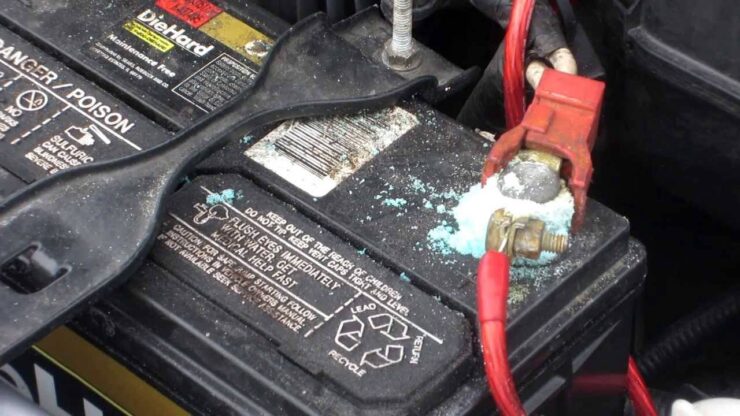Welcome to my comprehensive guide on how to clean corroded battery terminals. Corrosion on a car battery is not just an eyesore; it can severely impact the performance of your battery and, by extension, your vehicle.
In this guide, we will get into the nuances of battery maintenance, focusing specifically on identifying, cleaning, and preventing corrosion on battery terminals. Our aim is to provide you with a thorough understanding of the topic, presented in an engaging and accessible manner.
The Nature of It
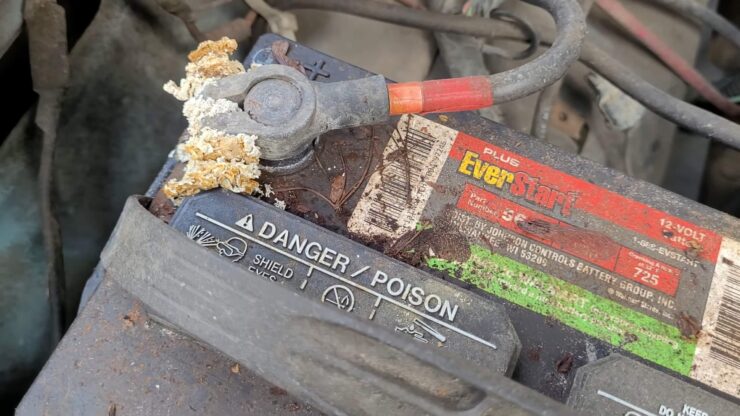
Battery corrosion often catches car owners by surprise. But what exactly is this substance, and why does it form?
This is typically characterized by a powdery, crystalline substance that forms around the terminals. This corrosion is the result of a chemical reaction between the battery acid and the metal of the terminals. Over time, this reaction produces compounds like lead sulfate or copper sulfate, depending on the material of the terminals.
The color of the corrosion can vary, often appearing white, green, or blue. The specific hue depends on the battery’s materials and the type of reaction occurring. This corrosion not only affects the aesthetic of the battery but also impedes the electrical connection, leading to reduced efficiency and potential vehicle malfunctions.
Identifying
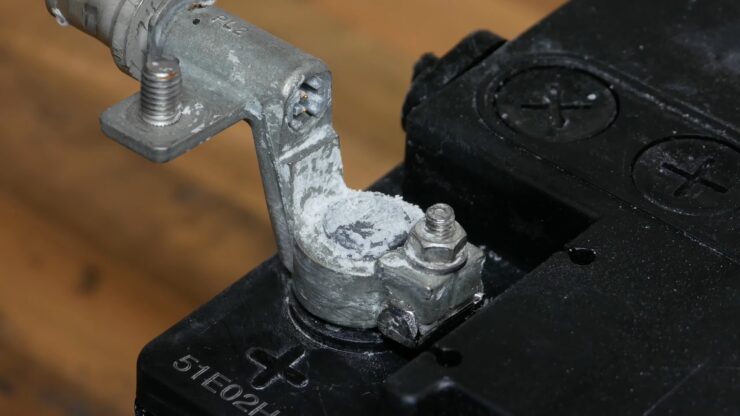
Recognizing the early signs of battery corrosion can save you from more significant issues down the line. Here’s what to look for.
Before inspecting it, ensure your vehicle has cooled down and that you’re equipped with safety glasses and rubber gloves. Corrosion is usually visible around the battery terminals – look out for crusty, powdery deposits.
The presence of these deposits can be a sign of underlying issues. Regular checks are recommended, especially if you notice any irregularities when starting your car or if any dashboard lights flicker or remain lit.
The Cleaning Process
Cleaning corroded terminals is a straightforward process, but preparation is key. Here’s how to get started.
Begin by assembling the necessary tools and safety equipment. This includes a pair of thick rubber gloves, safety glasses, a wire brush, and either a commercial battery cleaning solution or a DIY mix.
Ensure the vehicle is turned off and the keys are removed from the ignition. Start by disconnecting the battery cables, beginning with the negative (black) cable followed by the positive (red) cable. This step is crucial for safety and to prevent any electrical short-circuiting during the cleaning process.
Cleaning Methods
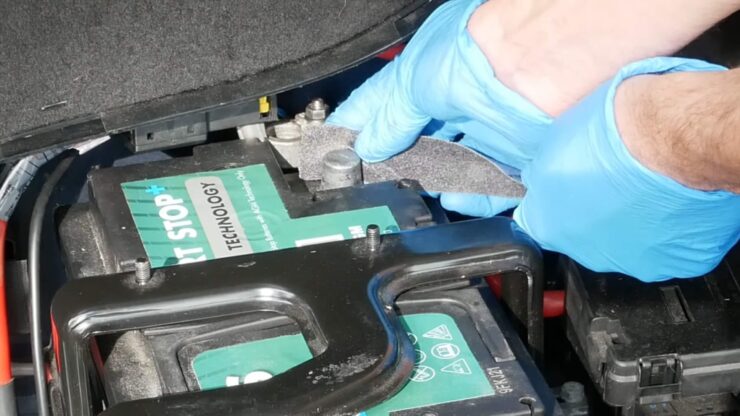
There are several effective methods for cleaning corroded battery terminals. Let’s explore the most common and effective ones.
For a commercial cleaner, apply it liberally over the corroded areas. Using your wire brush, gently scrub the terminals and surrounding areas until the corrosion is removed. Be thorough but gentle to avoid damaging.
- Spray the cleaner directly on the corroded areas.
- Use a wire brush for scrubbing.
A DIY method involves using baking soda and water. Sprinkle baking soda over the corroded areas and then add a small amount of water. This will create a fizzing reaction that helps neutralize and loosen the corrosion. After scrubbing off the corrosion, clean the area with a dry cloth to remove any residue.
- Apply baking soda followed by a small amount of water.
- Clean the area thoroughly after scrubbing.
Preventing Future Corrosion
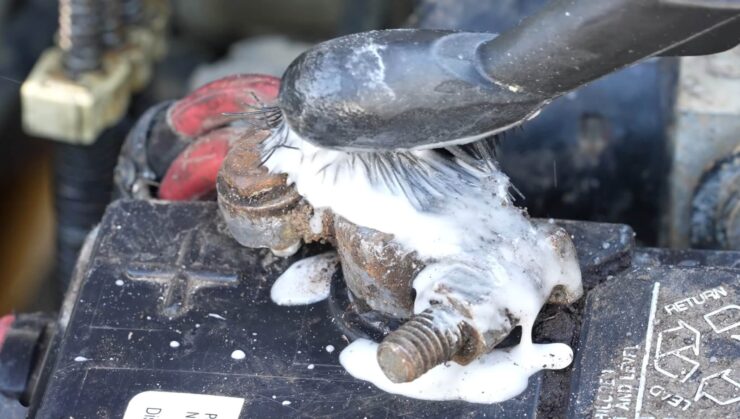
Prevention is better than cure. Understanding what causes corrosion can help you prevent it in the future.
Battery corrosion is often the result of the natural chemical reactions occurring within it. As a battery charges and discharges, it emits hydrogen gas, which can react with other substances in the environment, leading to corrosion.
Environmental factors like high temperatures, humidity, and even the quality of the electrical connections can accelerate the corrosion process. Regular maintenance and checks are crucial in identifying and mitigating these factors.
Tips for Preventing
Now that we know the causes, let’s explore practical tips to prevent corrosion on your terminals.
Regular cleaning is the first line of defense. Even if you don’t see visible signs of corrosion, periodically cleaning the terminals can prevent buildup. Using anti-corrosion sprays or gels after cleaning can also provide a protective layer against corrosion.
Checking and ensuring tight connections on the terminals can also help. Loose connections can lead to sparking and increased corrosion. Additionally, consider the environment where your car is parked. Reducing exposure to extreme temperatures and moisture can significantly prolong the life of your battery.
Detailed Cleaning Techniques
Commercial cleaning products offer a hassle-free solution to battery corrosion. Here’s how to use them effectively.
When using a commercial terminal cleaner, it’s important to follow the instructions on the product label. These cleaners are specifically formulated to break down corrosion without damaging the battery or the vehicle’s electrical system.
After applying the cleaner, allow it to sit for the amount of time recommended by the manufacturer. This ensures that the solution penetrates and loosens the corrosion. Afterward, use a clean cloth or brush to wipe away the residue, revealing clean and corrosion-free terminals.
DIY Cleaning Solutions
For those who prefer a more hands-on approach, DIY solutions can be just as effective. Let’s explore some common household items that can be used.
A popular DIY method involves a mixture of baking soda and water. The alkaline nature of baking soda neutralizes the acidic corrosion, making it easier to clean. Apply the paste to the corroded areas and scrub gently with a brush.
Another effective solution is using white vinegar. Apply it directly to the corroded areas and let it sit for several minutes. The acidic nature of vinegar helps dissolve the corrosion. Afterward, clean the area with a dry cloth to remove any vinegar residue.
Safety Measures
Safety should always be your top priority when handling car batteries. Here are the essential safety gears you should use.
Always wear protective gloves, preferably made of rubber, to prevent acid burns and electric shocks. Safety glasses are also crucial to protect your eyes from any splashes of corrosive material or battery acid.
In addition to gloves and glasses, wear clothing that covers your arms and legs. This ensures that your skin is protected from any accidental spills or splashes during the cleaning process.
Handling and Disposal
Proper handling and disposal of cleaning materials are vital for safety and environmental protection.
Ensure that any cloths or brushes used for cleaning are either properly cleaned or disposed of safely. If they contain hazardous materials, like battery acid, they should not be thrown in regular trash.
For environmental safety, avoid washing off cleaning solutions directly onto the ground. Instead, collect the runoff and dispose of it according to local hazardous waste disposal guidelines.
After-Cleaning Maintenance
Post-cleaning maintenance is crucial in prolonging the life of your battery. Regular inspection and cleaning can prevent the recurrence of corrosion.
Set a schedule for regular battery maintenance. This includes checking for signs of corrosion, ensuring the battery is securely mounted, and the connections are tight and clean.
During each inspection, clean the terminals even if there is no visible corrosion. This proactive approach can significantly reduce the likelihood of corrosion-related problems in the future.
Using Corrosion Prevention Products
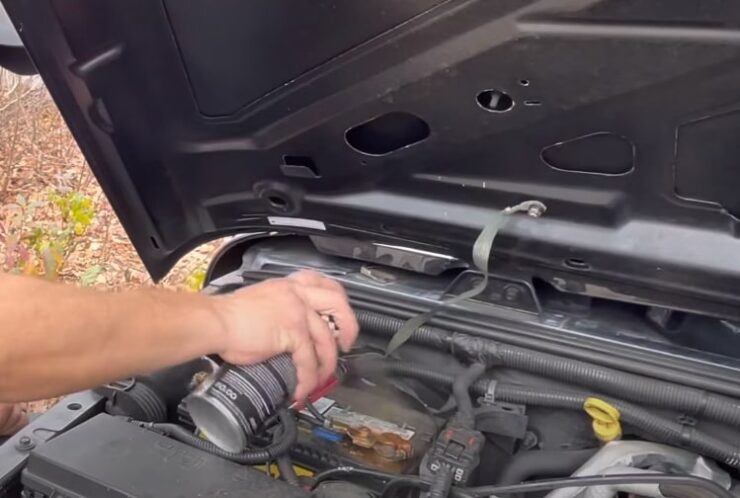
There are several products available that can help prevent battery terminal corrosion. Let’s explore some of these options.
Anti-corrosion sprays or gels can be applied to the terminals after cleaning. These products form a protective barrier that resists moisture and chemical reactions, which are primary causes of corrosion.
Battery terminal protectors, often in the form of washers or sprays, can also be used. These provide a physical barrier between the terminal and the corrosive elements, further prolonging the life of your battery.
Frequently Asked Questions
1. Can Corrosion Damage Other Parts of the Car?
Yes, unchecked corrosion can spread to nearby electrical components, potentially causing more extensive damage to the car’s electrical system.
2. How Often Should I Check My Battery for Corrosion?
It’s recommended to check your battery for signs of corrosion every time you have your car serviced, or at least twice a year.
3. Can All Types of Batteries Experience Corrosion?
Yes, most types of car batteries, including lead-acid, AGM, and gel batteries, can experience corrosion.
4. Are There Any Warning Signs Before Corrosion Becomes Visible?
Difficulty in starting the car, dimming headlights, and erratic electronic performance can be early signs of battery corrosion.
5. Can Corrosion Affect its Lifespan?
Absolutely, corrosion can significantly shorten a battery’s lifespan by impeding its ability to charge and discharge efficiently.
6. Is It Safe to Clean it Myself?
Yes, it’s generally safe if you follow the proper safety guidelines, such as wearing protective gear and disconnecting the battery before cleaning.
7. What Should I Do if the Corrosion Is Severe?
If corrosion is severe and has affected the battery’s performance, it may be best to consult a professional mechanic for advice or replacement.
Final Words
Thank you for joining us on this journey to understand and tackle battery terminal corrosion. Remember, regular maintenance and early intervention are key to keeping your battery healthy and your vehicle running smoothly. Stay safe, and happy motoring!

